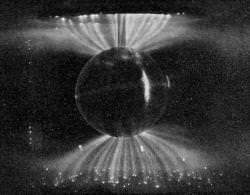Scientists working at the University of California, Los Angeles (UCLA) have identified the origin behind the upper atmospheric “hiss” that energizes the high-energy particles bouncing around inside Earth’s radioactive Van Allen Belts. This is significant, as this has been a very long wait for answers to the origin of this low-frequency radio wave emission… after 40 years of looking, we may now have an answer…
The Van Allen Belts surrounding Earth can be a terrifying place for spacecraft and astronauts. Occupying a volume 200 km above the surface and can extend as far as seven Earth radii (over 44,000 km). These volumes of highly energetic particles are trapped by the Earth’s magnetosphere, bouncing electrons and protons back and forth in their magnetic prison. The Van Allen Belts are variable and closely related to solar activity. As the solar wind hits the Earth’s magnetosphere, solar wind particles will fall into the polar cusp regions, entering the atmosphere and creating aurorae in Northern and Southern Polar regions (Aurora Borealis and Aurora Australis respectively). However, some particles are fed into the magnetosphere and become trapped between the onion skin-like layers of magnetic field lines and cannot escape.

This is how the Van Allen Belts are supplied, and the population of protons and electrons are expected to increase and become more energetic during solar storms. Although we know a lot about these regions, very little is known how the trapped electrons and protons are energized so much that they can penetrate lead up to 1 mm deep. This has obvious design implications for the thousands of satellites orbiting the Earth, and poses a serious health risk to astronauts spending long periods in space.
In new research published in Nature today, the UCLA research group believe they have found the origin of upper atmospheric “hiss”. The hiss has radio wave frequencies and has been observed since early missions into space in the 1960s. Thought to originate from magnetic interactions in the magnetosphere itself, or even from intense lightning storm emissions into the upper atmosphere, definitive proof for the source of this strange phenomenon was proving very elusive. Putting classical ideas to one side, Jacob Bortnik’s work focuses on a totally different form of electromagnetic wave called “chorus”. This wave was thought to have no connection with radio hiss, but Bortnik proves that chorus waves, travelling many thousands of kilometres, can evolve into the hiss which characterizes the Van Allen Belts.
“Here, we show that a different wave type, called chorus, can propagate into the plasmasphere from tens of thousands of kilometers away and evolve into hiss. Our new model naturally accounts for the observed frequency band of hiss, its incoherent nature, its day-night asymmetry in intensity, its association with solar activity and its spatial distribution. The connection between chorus and hiss is very interesting because chorus is instrumental in the formation of high-energy electrons outside the plasmasphere, while hiss depletes these electrons at lower equatorial altitudes.” – Jacob Bortnik.
The UCLA group were actually not researching the atmospheric hiss, but were working on chorus waves – that typically propagate outside the plasmasphere – and realized they could evolve into the “hiss” responsible for particle energization in the Van Allen Belts.
This research has massive consequences for the prediction of space weather. The conditions of the space between the Sun and Earth is very important when predicting the onset of a solar storm, but the reaction of the Earth’s upper atmosphere is critical when understanding how potentially damaging particles are energized to such a large extent.
Source: Physorg.com


To Bruce:
The frequency range of this hiss is between 100 Hz to several kHz. I haven’t come across any articles on picking up this signal on the ground – I suspect it doesn’t penetrate the atmosphere very far. The waves most likely get absorbed very quickly.
Hope that helps 😉
Ian
I wonder how strong would be the Van Allen belts around jupiter or even the sun; they must be of an enormous influence.
Does anyone know just what is the band of frequencies are, and can they be heard on a communications receiver?
Thanks for the reply Ian.
Sounds to me that the hiss will be lost in the normal receiver noise in any case.
Just thought it would be interesting to try.
Bruce.
I do remember hearing something about being able to hear radio waves Jupiter’s Van Allen Belt interactions in an isolated area, so I would assume it is possible to hear our own.
sub: Cosmos Yoga-Confirmation
This article helps to highlight the Necessity-Demand-Curiosity-Sustenance structure for advancement of Science in tune with Philosophy and Nature..East-West Interaction helps in time
The frequencies are tuned for the Spinal Column and received by Human Brain as well.Some useful information is included in my books- Cosmology-Vedas Interlinks- Cosmos Yoga Vision series(1-4)
Vidyardhi Nanduri
Vidyardhi Nanduri